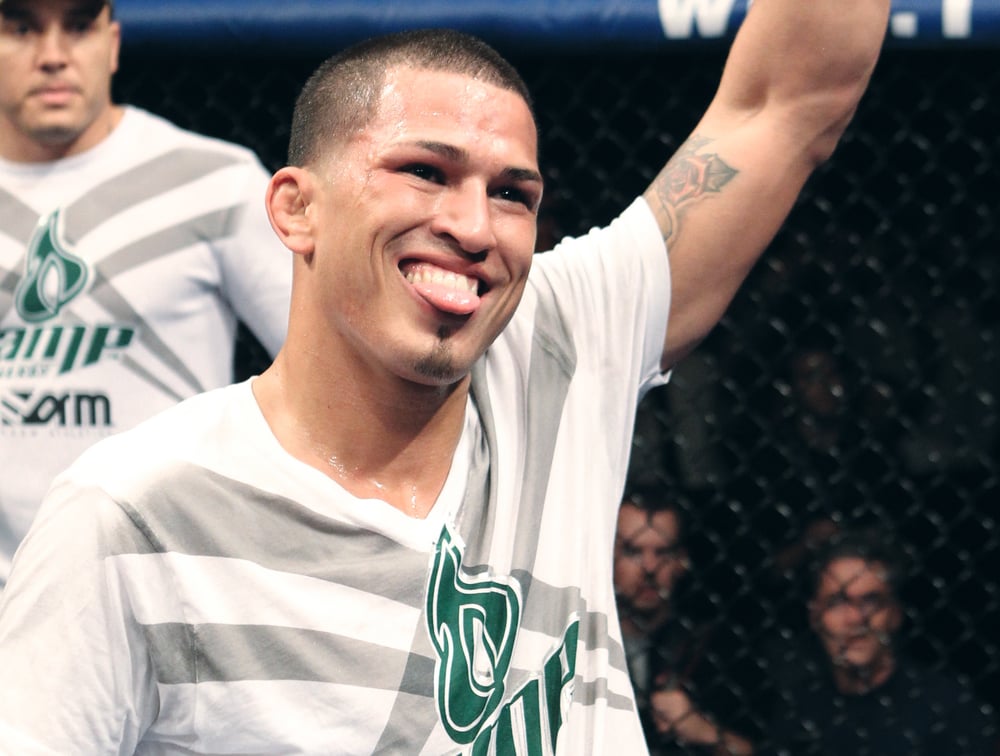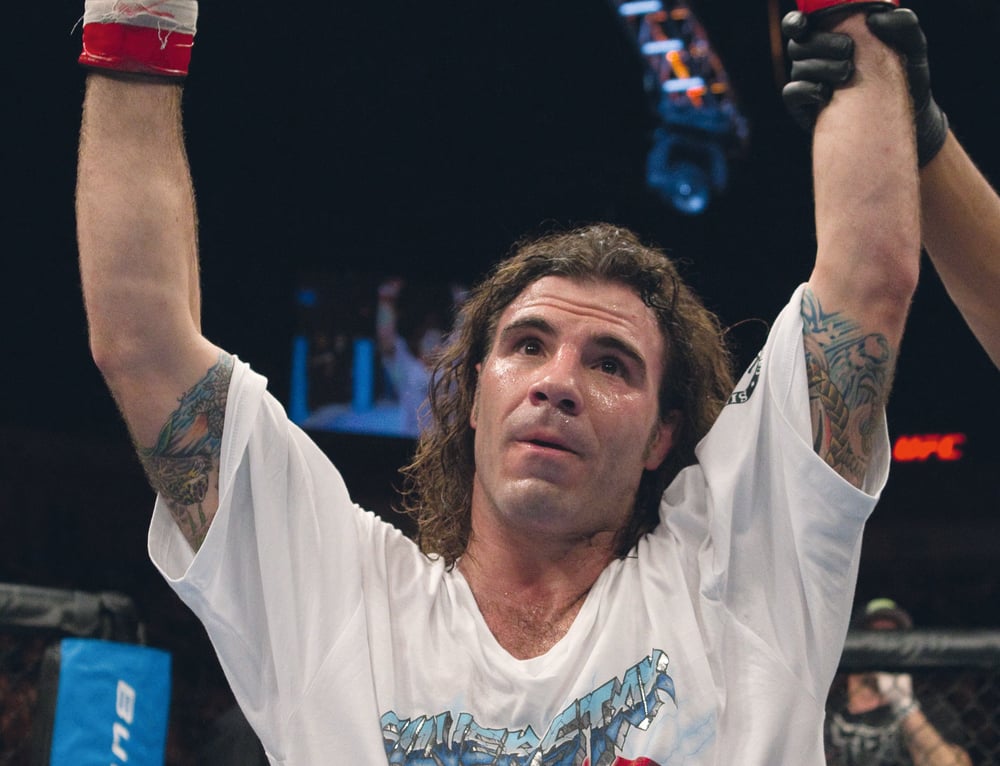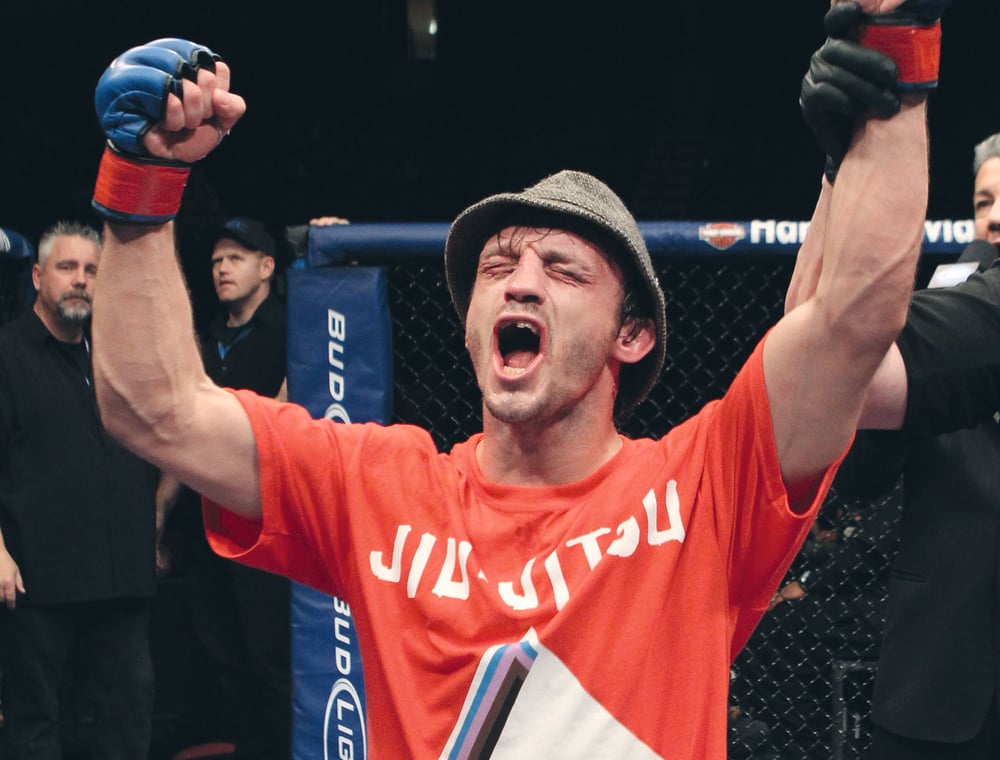
Issue 076
June 2011
First, FO analyst Andrew Garvey takes a look at the state of play: what are the career implications for the combatants? Where are they coming from, and what will victory or defeat hold? Next, our technical editor Pete Irving breaks down the athletic considerations.
71%
Of the 156 strikes Lesnar has landed in the UFC, a massive 71% of them have been on the ground. Brock Lesnar held the UFC heavyweight title for 707 days, or nearly two years, with two successful defenses
7
Junior dos Santos is on a seven-fight win streak that dates back to an October 2007 armbar loss. Aside from his unanimous decision against Roy Nelson he’s finished every one of them.
89%
The Brazilian has avoided 89% of takedown attempts in the UFC
1
Despite being one inch shorter than Dos Santos, Brock Lesnar actually has a reach advantage of four inches on the Brazilian. It’s the same edge he had over Cain Velasquez
THE BIGGER PICTURE
Former UFC Heavyweight champion, NFL hopeful, WWE star and twice an NCAA All-American wrestler, Lesnar is still only 5-2 as a professional fighter. He’s also either – depending on your viewpoint – one of the greatest athletes MMA has ever seen, or a big, useless fraud who only won the title because of his size. It’s difficult for anyone not to have an opinion on the man who won a UFC championship in only his fourth professional fight. But Lesnar, for all his inexperience, beat Heath Herring like a drum, smashed Randy Couture to bits in winning the title, annihilated Frank Mir, and survived a torrid first round to submit Shane Carwin. No oversized non-fighter could have done that. True, he turns 34 a month after this one and seemed to fall apart when hit by Cain Velasquez, but Lesnar remains a very dangerous part of the UFC title picture. The supremely talented Velasquez is going to make a lot of heavyweights look like bumbling amateurs, so losing to him is certainly no disgrace. How Lesnar learns and ultimately rebounds from that defeat may decide who wins this fight.
Lesnar’s rival Ultimate Fighter coach, Dos Santos (12-1), enters by far the biggest fight of his life on a seven-fight UFC winning streak. In a five-year career only Roy Nelson has gone the distance with him. Boasting fast hands and genuine knockout power, Dos Santos has finished Fabricio Werdum, Stefan Struve and Gabriel Gonzaga with his fists. He’s also toppled over-the-hill strikers Mirko ‘Cro Cop’ and Gilbert Yvel. Far more precise and well schooled on the feet, he can and will hurt Lesnar if the huge American can’t take him down. But Dos Santos has never shown the kind of takedown defense that suggests he can stop Lesnar muscling him to the mat. Few have seen the 26-year-old Brazilian’s ground game since he usually beats people up early (only the Nelson and Cro Cop fights left the first round), but years of training under Antonio Rodrigo Nogueira suggests he knows what he’s doing.
With some 12 weeks of TUF exposure, Dos Santos will massively raise his profile, while Lesnar is already a fighting superstar and without question the biggest pay-per-view seller in the entire sport. Whoever wins is next in line for a UFC heavyweight title shot once Velasquez recovers from the torn rotator cuff he suffered in the Lesnar mugging. Brock-Cain II will be intriguing and will generate enormous amounts of cash and media interest, but Dos Santos vs Velasquez, pitting two elite, ‘next generation’ 20-something’s against each other could be a truly epic fight from bell to bell. Whichever fighter wins on June 11th, the next UFC heavyweight title fight is going to be huge.
TECHNICAL BREAKDOWN
Lesnar, in spite of having been “exposed” by Carwin and Velasquez, remains a fearsome physical prospect for any heavyweight in the world. Essentially a super heavyweight without an existing division to compete in, he can move his gargantuan frame at a frightening speed when he rushes in for the leg tackle, like few other athletes his size can.
Unfortunately for him, the same over-muscled physique that makes his double-leg virtually unstoppable also renders him unable to strike with technical proficiency or cover up the angles against oncoming blows. Lesnar’s lead hand paws out in front or levers up and down, waiting to club with the right. The enormous fuel demands of the muscle he carries make it hard to keep pace with slightly smaller, more mobile heavyweights, in spite of Lesnar’s workhorse training ethic.
Once Lesnar is on his back he lacks the hip mobility to re-guard effectively and struggles to scramble up. Conversely his top game is only heavy by virtue of his weight and his technically deficient pinning and covering was shown up when faced with the wrestling skill of Velasquez, who though unable to foil Lesnar’s initial shot, scrambled to his feet again with apparent ease.
Whilst ‘Cigano’ may not carry the huge bulk of Lesnar, he is by no means an undersized heavyweight. The Minotauro Team representative brings to the cage just what one would expect from a Minotauro fighter; good boxing and good jiu-jitsu. For such a big man, Dos Santos has a broad vocabulary of punches, mixing up straights, hooks and uppercuts in tidy combinations. And with his 77-inch reach he works the angles in just the way that saw Lesnar fall foul of Velasquez. Dos Santos has rarely seen his way beyond the first round thanks to his fast movement, well picked punches and a ferocious killer instinct that sees him chase his opponents down after knocking them to the floor, hammering away to a finish. This style has produced nine first round finishes in his 13-fight pro career, the majority being by way of (T)KO.

TUF 13 Finale, June 4th, Las Vegas
Anthony Pettis vs. Clay Guida
2
Anthony Pettis and Clay Guida have both held Zuffa-owned titles. Pettis was the last WEC lightweight champion and Guida held the Strikeforce 155lb belt in 2006
35%
Guida has landed only 35% of his 1,068 UFC strikes
53%
Win or lose, 53% of all Guida’s fights have ended in a tapout – the most common method either way being the rear naked choke
8
Between the two of them, Pettis and Guida have earned an ‘…of the Night’ bonus eight times in 19 fights – or 42% of the time
16
Pettis was 16 years old when Glay Guida made his MMA debut in 2003. It was another four years and 28 Guida fights until Pettis would have his first pro bout

THE BIGGER PICTURE
Few things in life seem more guaranteed than Pettis (13-1) and ‘the Carpenter’ (28-11) putting on a great show for the fans in a UFC lightweight title eliminator. Coming off his WEC 155lb belt win over Ben Henderson in a cracker highlighted by ‘that’ kick which attracted so much attention from the sports world (ESPN listed it in the top 10 plays of the year in any sport), 24-year-old Pettis is a dangerously inventive striker. A protégé of respected kickboxing coach Duke Roufus, Pettis started out in early 2007. Two years later, he was a WEC fighter and amassed a 5-1 record, losing only a very close fight to veteran Bart Palaszewski. Pettis has beaten good wrestlers before, most notably Henderson and Shane Roller, but few wrestlers are as relentless as the ever-popular Guida. Setting a frenetic pace from bell to bell, Guida is entering his 14th fight in the Octagon and has been a UFC regular since late 2006. A former Strikeforce lightweight champion, Guida is 8-5 as a UFC fighter but has won three in a row, all of them inside the distance. He’s struggled with fast-paced strikers who can negate his wrestling before, losing to Roger Huerta and Diego Sanchez, the latter in the best fight of 2009. Can Guida fend off Pettis’ strikes and keep him on the mat? Can Pettis handle Guida’s pace and greater experience? We’re all sure to have a lot of fun finding out.
TECHNICAL BREAKDOWN
Pettis garnered much recognition for his spectacular head kick knockdown of Ben Henderson at WEC 53, bounding off the cage wall to exploit Henderson’s lazy guard as he circled away. Far from being an unprecedented move on Pettis’ part, the prolific finisher known as ‘Showtime’ has put away 11 of his 15 opponents, often thanks to his powerful and lightning-fast head kicks and punishing right-leg low kicks, either directly or by virtue of attrition. Pettis sets his kicks up with his long hooking punches and delivers the high kick without warning.
Guida, with his low elevation from the deep crouch he adopts, presents a very kick-able target. Only the ever-present threat of his driving takedown dissuades his opponents from kicking to his open lead leg or across his guard. Guida sets up his low double-leg with intense forward pressure, flurries of hooks and wild, leaping kicks that force the opponent on the back foot before he shoots low with the head in the center when shooting from outside the clinch, upsetting the balance and deftly avoiding any chance of being guillotined. When finishing against the wall Guida gets good amplitude on his doubles and slams his opponents with authority. This could be problematic for the taller Pettis with his notably higher stance.

UFC 130, May 28th, Las Vegas
Miguel Torres vs. Brad Pickett
8
Brad Pickett will give up eight inches in reach to Miguel Torres. The latter has a 76-inch range – massive for a featherweight – while the Brit owns 68 inches
11%
Torres has only avoided 11% of takedown attempts in his WEC-UFC career
2
Before joining the WEC as a bantamweight, Pickett held two titles at featherweight in the UK. He won the Cage Rage belt in 2005 and the Ultimate Challenge strap in 2009
54%
Pickett has successfully completed 54% of his takedowns in his WEC fights
48%
Against Antonio Banuelos in his last fight, Torres connected with the jab on 48 of 125 attempts

THE BIGGER PICTURE
British brawler ‘One Punch’ Pickett (20-5) has come a long, long way since he was tearing up Cage Rage undercards back in 2004 and 2005. A loveably tenacious, trilby-hatted brawler in those days, the 32-year-old is a far, far better fighter now. A former featherweight, Pickett finally started getting the wider attention his talent and habit of putting on great fights deserved, when he signed with the WEC as a bantamweight. Going 3-1 in the blue cage, he lost to future title challenger Scott Jorgenson and racked up impressive wins over Demetrious Johnson and Ivan Menjivar. With the WEC/UFC merger, Pickett is set for a very tough UFC debut against Torres (39-3). Hopes were high for Torres’ February UFC debut against Antonio Banuelos. Sadly, a fight which promised fireworks, ended up a hesitantly tactical three rounds of masterful stifling. Usually a murderously entertaining fighter, Torres, now with Greg Jackson, was nothing like the destroyer of his 2008-09 WEC bantamweight title reign. Perhaps with that UFC debut out of the way, Torres will open up a little more. If anyone can force him into a more characteristically crowd pleasing battle, it’s Pickett.
TECHNICAL BREAKDOWN
UK standout Pickett thrives in a hard fight. The tougher the fight gets, the tougher Brad gets. Pickett has retained all the positives of the style which made him a hometown hero in the heyday of Cage Rage; the will to trade leather fearlessly and the intense workrate. But, since making the move to ATT, he has steadily refined the brawling style into a comprehensive, skillful boxer/wrestler package. Pickett, although retaining the ‘brawler’ tag, actually has a sensitive and highly developed anti-jiu-jitsu grappling style; effectively neutralizing guard attacks with good balance, posture and hip pressure, enabling him to unleash heavy ground ‘n’ pound.
Pickett takes his already low elevation lower with crouching posture, offering up the lead leg to a low kick, but constantly ready to shoot the double or leap into range with the heavy left hook. Torres hunches up at the shoulders but stands very upright with a fairly narrow stance. He has a tremendous reach advantage over the majority of his division but, occasionally, especially when fatigued, steps in too much behind his straight punches and robs himself of the reach advantage. Like all tall, limby fighters, Torres struggles to punch on the inside and can find himself tucking in and lowering his head to brace against flurries of punches once he gets backed up – as against Mizugaki and Maeda. As with all bouts with a height and reach discrepancy between combatants, in the stand-up phase the success or failure of Pickett’s attacks hinges on his ability to enforce his own range and pace on the contest.










